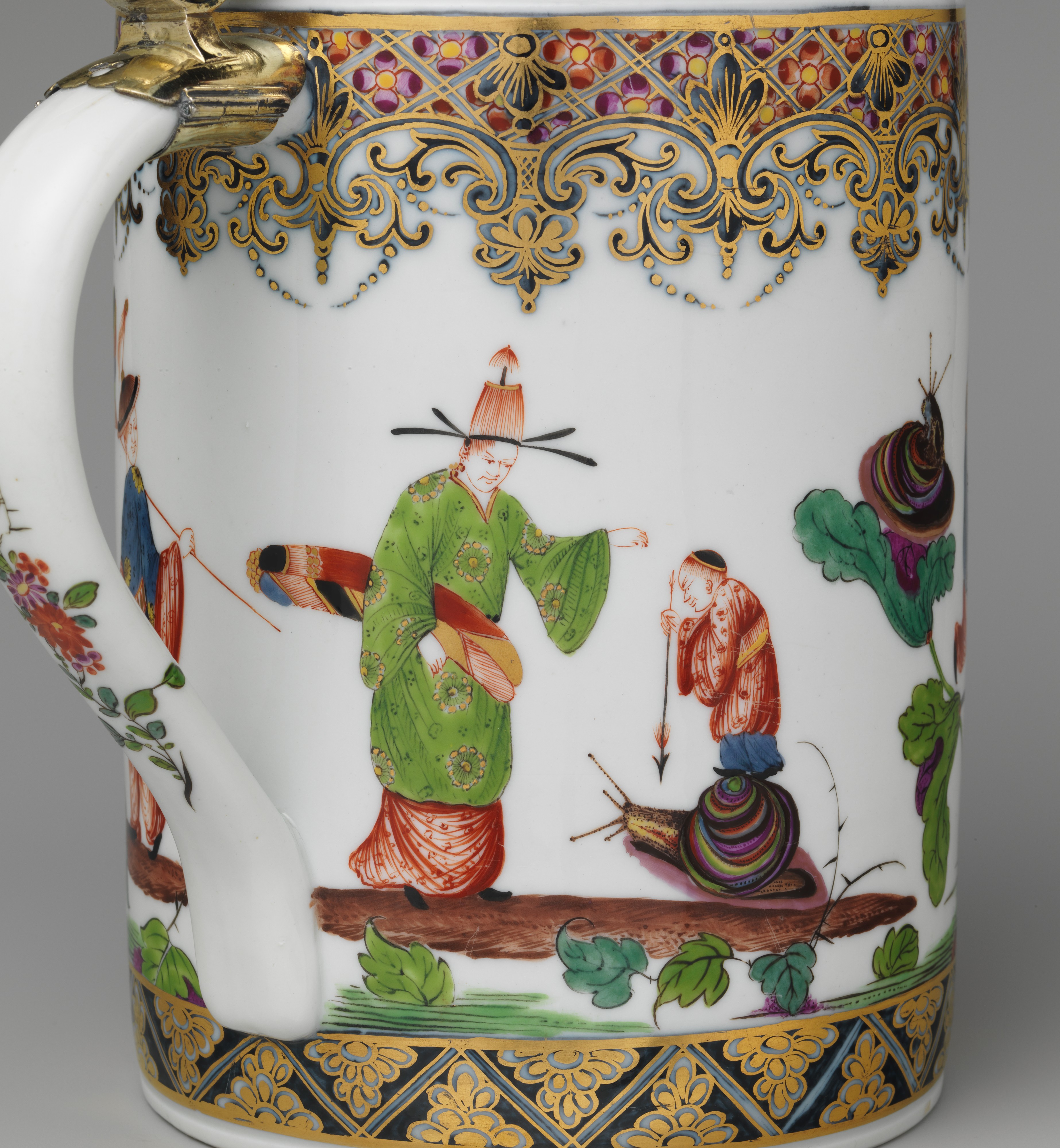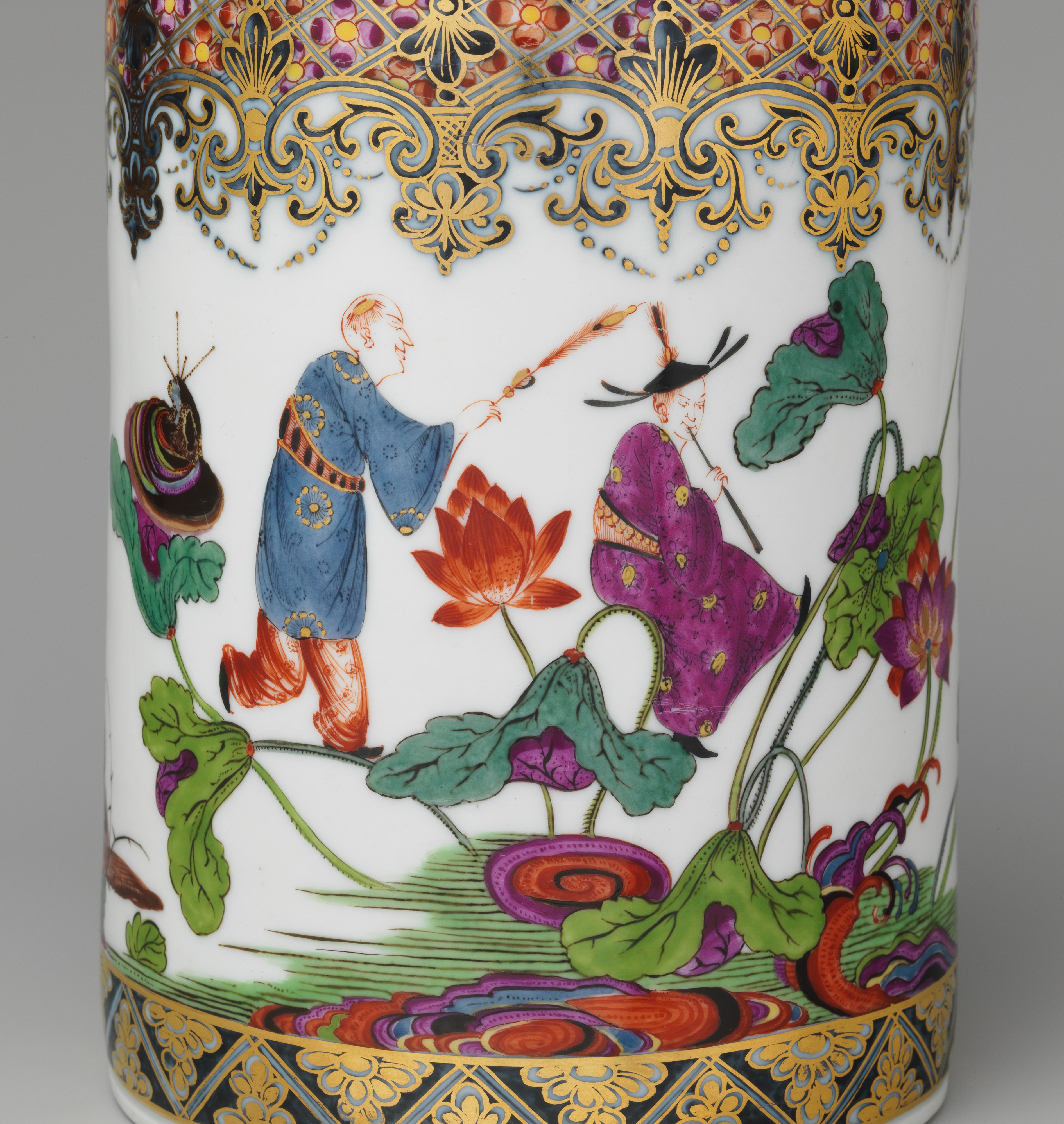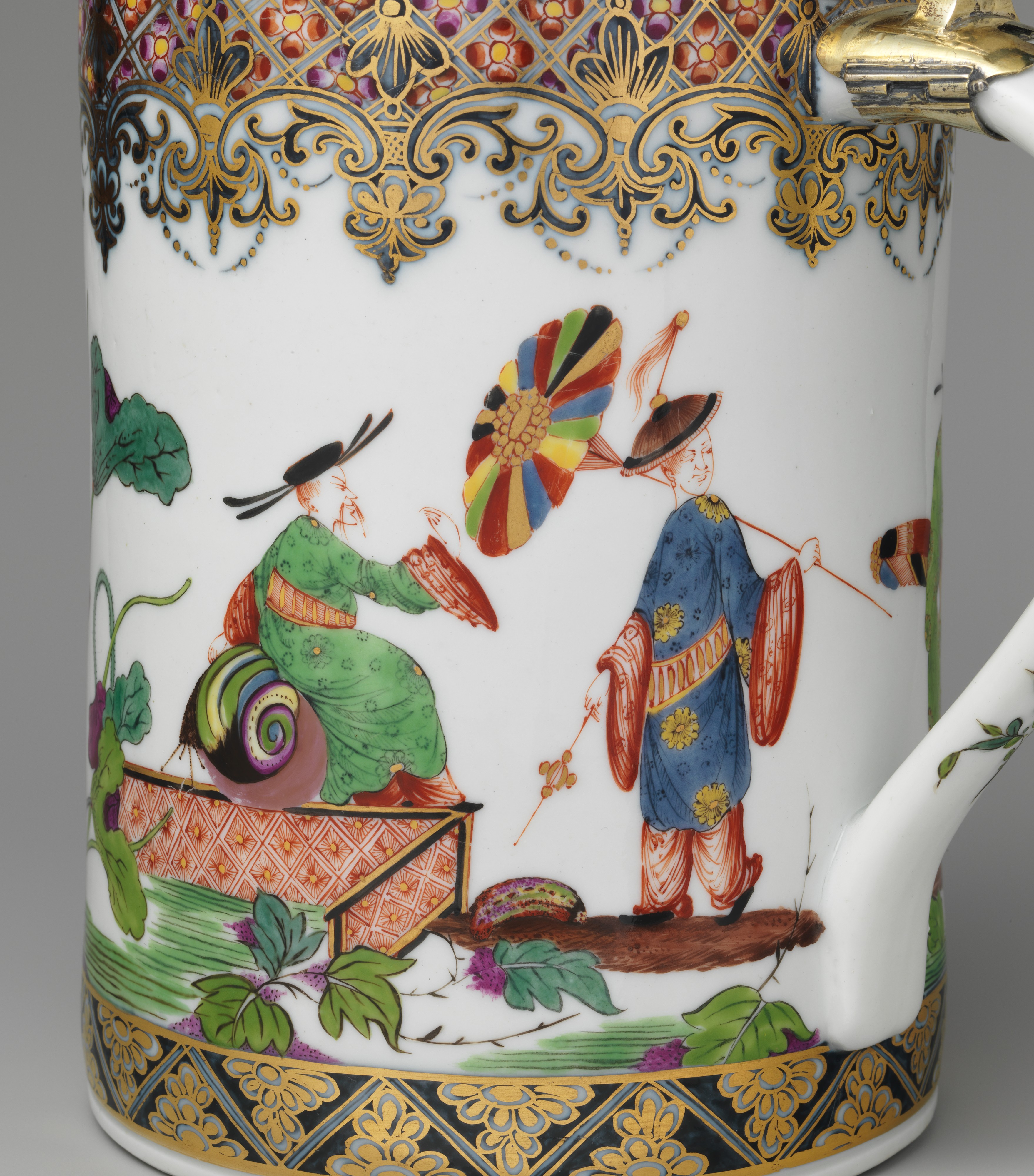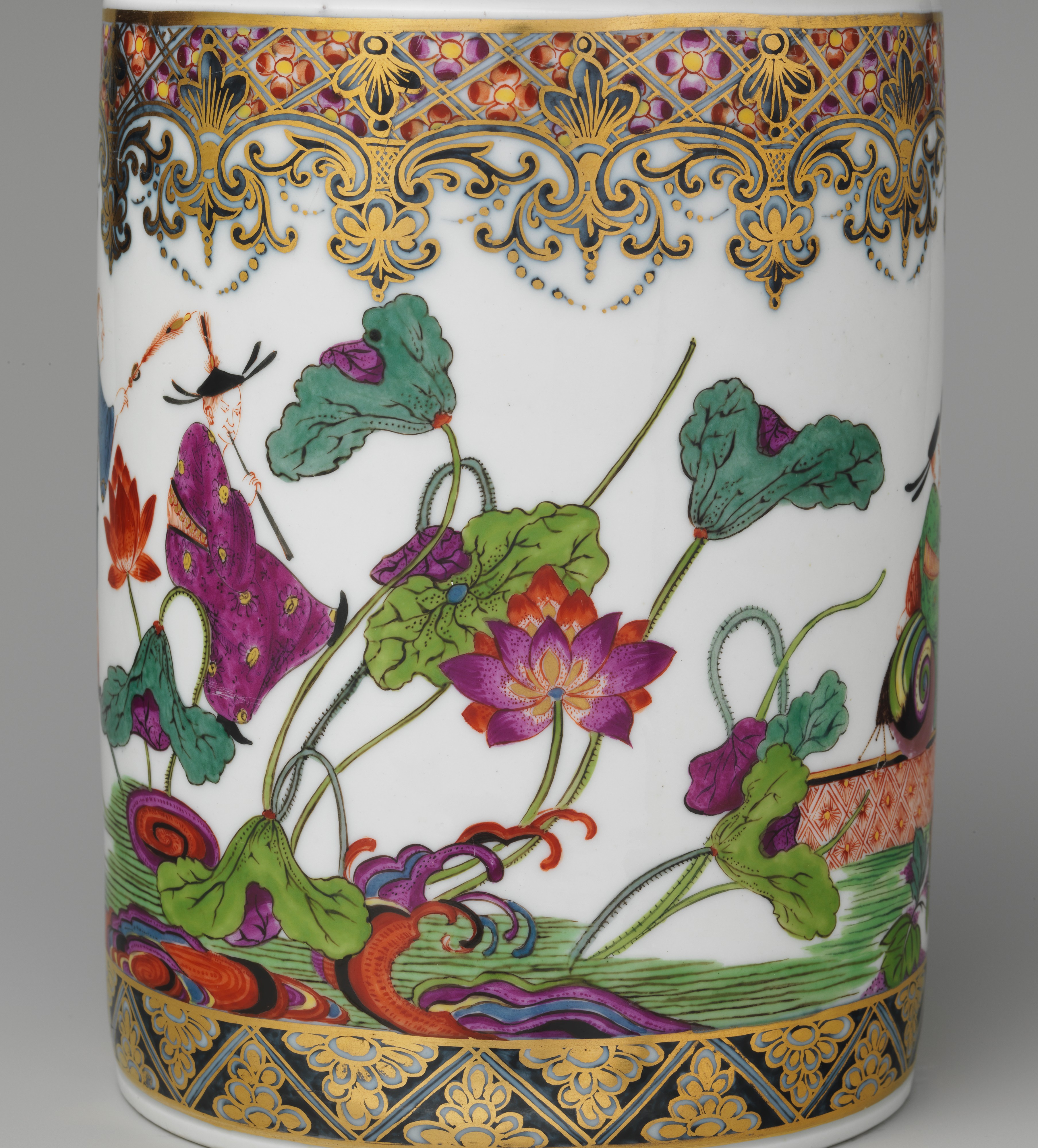Tankard
Manufactory Meissen Manufactory German
Painted decoration in the style of Johann Ehrenfried Stadler German
The Chinese and Japanese porcelains in the collection of August II (1670–1733), commonly known as Augustus the Strong, elector of Saxony, king of Poland, provided a wealth of decorative styles and motifs for the painters at the Meissen factory to copy and reinterpret. Certain imported models were copied with great fidelity, but often the imported porcelains provided a decorative vocabulary from which motifs could be selected and combined for use in innovative ways. On this magnificent tankard, the depiction of large, sinuous lotus leaves derives directly from so-called famille verte porcelains made in China during the late seventeenth and early eighteenth centuries.[1] Famille verte, a French term meaning “of the green family,” was first used in the late nineteenth century to describe a large group of Chinese porcelains in which a translucent green enamel dominates the palette.[2] Other enamel colors, such as iron-red, yellow, blue, and black, were employed on famille verte porcelains, but the brilliant and luminous green developed by the Chinese painters is customarily the immediately distinguishing feature of these works. A broad range of compositions and motifs appear on Chinese porcelains belonging to this group, yet those decorated primarily with lotus leaves and flowers make up a small but distinctive category.[3] Characteristically, the depictions of the lotuses employ boldly undulating lines, as well as a marked contrast between the irregularly shaped masses of the leaves and flowers and the delicacy of the sinuous stems. Birds and waterfowl are sometimes included in the compositions, but the lotus plants are always the dominant feature.[4]
The lotus leaves and flowers on the Museum’s tankard are rendered in the conventional Chinese manner, but here they are populated with chinoiserie figures and snails that have been given equal compositional weight. One of the figures balances on a lotus leaf stem as he fans a seated figure sitting on a bended stem. One of the snails is perched on a leaf; a second snail is ridden by a child. Three additional figures occupy the fantasy landscape dominated by the oversize lotus plants, and all the figures are painted in a manner traditionally described as that associated with the Meissen painter Johann Ehrenfried Stadler (German, 1701–1741). It is not possible to attribute the decoration to a specific painter, but the chinoiserie figures are very much in the style promulgated by Johann Gregorius Horoldt (German, 1696–1775) (see 54.147.75, .76) The tankard’s painting, especially that of the faces and costumes, is of the highest quality, and the richly detailed aquatic landscape is depicted with a level of skill and with a diversity of palette that marks this object as one of the factory’s exceptional works.
The complexity of the composition is particularly evident when the tankard is compared to other Meissen porcelains decorated with lotus plants in the famille verte tradition. The closest comparisons are offered by a vase in the Schneider Collection at Schloss Lustheim near Munich,[5] a tankard in Berlin,[6] and a waste bowl (for used tea leaves) in the Arnhold Collection, New York,[7] all of which follow the Chinese model closely, with few compositional deviations from the famille verte prototypes. A beaker vase with lotus decoration in Berlin includes two chinoiserie figures,[8] yet they are subsidiary to the plant motifs, and hence the vase’s painted composition does not reflect the innovative balance of Chinese-inspired decoration and Horoldt chinoiseries that distinguish the Museum’s tankard.
The tankard is remarkable as well for the two continuous borders painted at the base and below the rim. The border at the top is not only unusually large in scale but also particularly complex in its design and palette, incorporating polychrome four-petaled flowers within a lozenge pattern, with C-scrolls and foliate motifs along the lower edge of the border. Both borders are partially painted in cobalt blue that was applied under the glaze, which indicates that the design of the borders had to have been determined before the glaze and enamel firings. The interplay between the underglaze blue and the gilding is especially elaborate, suggesting that the tankard was intended from the outset to be a particularly ambitious work.[9] This supposition is reinforced by the tankard’s size, which is one of the largest produced by the factory.
The silver-gilt lid and thumb piece are almost certainly original to the tankard, and while mounts such as these are often regilded, the gilding here appears to be original as well. Interestingly, the three-leafed motif of the thumb piece echoes a similar motif found in the decorative painted band at the top of the tankard’s body. While the mark stamped on the cover indicates that it was made in Dresden, the scrolling designs of the engraved decoration reflect the influence of Augsburg goldsmiths whose work set the standards for German metalwork during this period. The cover incorporates in the center a medal depicting the Marriage of Cana, which raises the possibility that the tankard was intended to be presented as a gift to celebrate a wedding.
Footnotes
(For key to shortened references see bibliography in Munger, European Porcelain in the Metropolitan Museum of Art. NY: The Metropolitan Museum of Art, 2018)
1 For the most comprehensive survey of famille verte porcelains, see Jorg 2011.
2 Ibid., p. 9.
3 For example, see Chinese Porcelain 1986, p. 98, no. 117; Strober 2001, p. 72, no. 29; Jorg 2011, pp. 53, 62, 64, nos. 48, 63, 65.
4 Jorg 2011, p. 62, no. 63.
5 Weber 2013, vol. 2, pp. 336–38, no. 322.
6 Bursche 1980, p. 218, no. 204.
7 Cassidy-Geiger 2008, p. 395, no. 155b.
8 Bursche 1980, p. 219, no. 206.
9 Another tankard with unusually prominent borders in underglaze blue with gilding is in the Pauls Collection; Meister 1967, vol. 1, pp. 96–97.
Due to rights restrictions, this image cannot be enlarged, viewed at full screen, or downloaded.
This artwork is meant to be viewed from right to left. Scroll left to view more.






